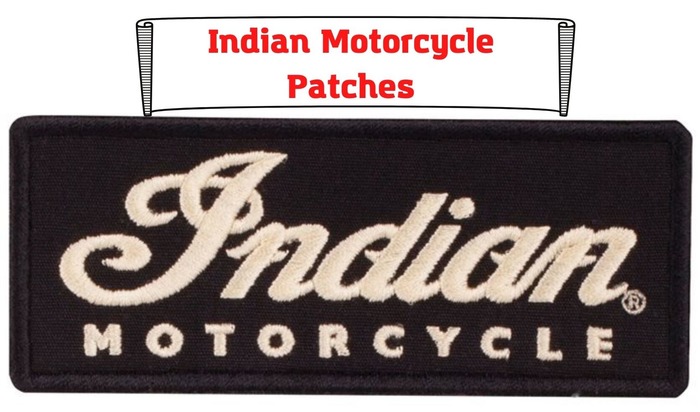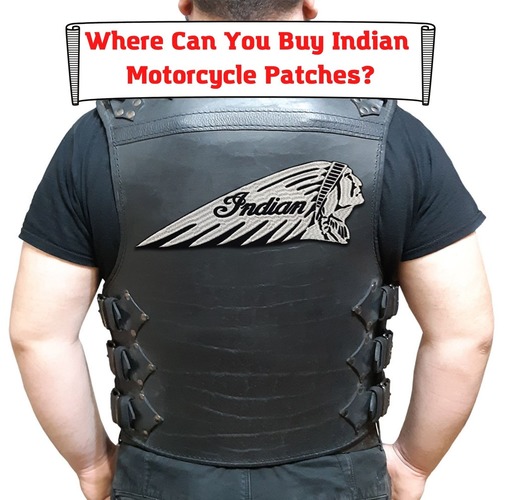
We often see bikers putting on jackets or vests adorned with eye-catching patches. It's no surprise why people assume that bikers wear patches for decorative purposes. Far from that, they are a unique part of the biking culture. Bikers wear the patches to pass on a message known to fellow bikers. They adorn these patches to show their allegiance to a particular motorcycle club, riding group, or motorcycle organization. These patches often bear the club's, group's, or the organization's logo, location, and name.
You need to understand how the patch came to be if you intend to purchase or own a customized Indian Motorcycle patch. Pore over the article to understand the basics of Indian Motorcycle patches, history, and reasons to own one.
What Are Motorcycle Patches?
Motorcycle patch is part of the biking culture. It reflects the free-spirited nature of a biker. Motorcycle patches are adornments worn by bikers as a symbol of identity and unity among motorcycle clubs or groups.
Motorcycle patches have been in existence since the 1920s, and frankly speaking, they are here to stay. Bikers invented them as a sign of support and to show fellow bikers their allegiance to a particular motorcycle club. They also created it as an embellishment to their outfits. Bikers wear them on their vests.
Indian Motorcycle Patch Origin
The Indian Motorcycle® came into being way before the biker culture became a thing. The owners founded Indian Motorcycle in 1901 and have since maintained its colorful and visual history. A native American man has always been part of the company's brand identity.
The Indian Motorcycle patches can be boiled down to the late 1920s to the early 1930s when the biker culture came into being. Friends or family members who enjoyed riding Indian Motorcycle motorcycles would form a group. The American Motorcyclist Association (AMA) would register and sanction these groups and clubs.
The association would then organize events to commemorate the biking culture. A group of motorcycle lovers from the same locality or who shared the same interest would gather at such an event to celebrate the biking culture. Such groups often had the names of their groups sewn on their jackets or groups' clothing.
AMA would then award the best-dressed motorcycle clubs or groups at such events. To perk up their dressing game, clubs started wearing motorcycle club patches. Before 1947, bikers wore the patches as decorative pieces. Over time, bikers used motorcycle patches to express their riding skills, distinctive character and used the patches as an identity.
But when rowdy biker groups sprouted, AMA outlawed them. This brought to light the 99% and 1% motorcycle patch. The 99% patches were adorned by sanctioned groups, while the outlaw biking groups wore the 1% patches. The one-percenters divided their patches into three pieces to differentiate from AMA-sanctioned groups.
As a brand patch, the Indian Motorcycle patches also communicated the mission of the Indian Motorcycle Riding Groups, the completion of riding challenges, and the love for the Indian Motorcycle brand. A rider who adorns the Indian Motorcycle patch wears it as a sign of merit for the motorcycle organization and riding group. The patches also show the other riders that the user owns an Indian Motorcycle.
The Indian Motorcycle riders group designed its patches with the essence of its brand in mind. The patches vividly showcased the Indian Motorcycle rider's individuality and heritage.
Indian Motorcycle Patch as a Brand
Anytime you adorn an Indian Motorcycle patch, you identify with the Indian Motorcycle® brand. if you love the Indian Motorcycle brand, proudly show it off with a patch. All the Indian Motorcycle patches come with the three Indian Motorcycle® colors: crimson steed red, brown, and gold.
If you plan on owning one, there are brand standards you ought to adhere to before customizing or wearing the patch.
The back patch or riders group identity patch must be surrounded by an exclusion zone. The patch needs to stand out and not be hidden on a heap of motorcycle patches.
You should retain each element of the Indian Motorcycle logo on your patch. If you intend to use a smaller logo, you need approval from the Indian Motorcycle®.
Don't redesign the logo.
A legit Indian Motorcycle patch should contain the legendary Indian Motorcycle logo.
Types Of Indian Motorcycle Patches
One-Piece Indian Motorcycle Patch
Bikers wear the one-piece biker patch to signify their allegiance to a particular riding group, club, or organization. The One-piece Indian Motorcycle patch denotes your loyalty to the Indian Motorcycle organization or riders’ group. The piece also exhibits your Indian Motorcycle rider's elite status. The one-piece patch often holds the club’s name, riders’ group, or logo of a riding organization, and territory.
Two-Piece Indian Motorcycle Patch
A two-piece patch shows the transitioning phases of the user. It indicates that they are waiting for approval from the clubs' leadership. Once approved, one is permitted to wear the three-piece biker patch. When customizing your patch, you need to be extra careful with the design on your patch. It should not be like the design of other local motorcycle clubs.
Three-Piece Indian Motorcycle Patch
The three-piece patch shows that you are connected to a motorcycle club. The three-piece biker patch comes in three pieces, a top rocker, logo/club’s symbol, and a bottom rocker. The top rockers showcase the club's name, the emblem contains the club's logo, and the bottom rocker shows the locale of the motorcycle club. The three-piece also proclaims that the dominant motorcycle club in the region has approved the group.
To attain this patch, you should be a sanctioned member of a club. You'll go through an assessment process before being accepted as a fully-fledged member of the club. Adorning the three-piece ties you to the club's protocol, rules, way of conduct, and culture.
Although the Indian Motorcycle is not a club, the patch also comes as a three-piece. It comes as a head patch, logo patch, and motorcycle patch. The motorcycle patch shows the type of Indian Motorcycle you own. If you own a scout Indian Motorcycle, the motorcycle patch will contain the scout owner embroidery. The logo patch houses the Indian Motorcycle logo, and the head patch holds the name of your riding group.
What Are Indian Motorcycle Patches Made Of?
Indian Motorcycle patches are made from tough materials like cotton, polyester, or denim to hold out against harsh weather conditions. They come with full or minimal embroidery. Full embroidery patch is a top-quality Indian Motorcycle patch with full embroidery coverage. If you want a detailed Indian Motorcycle patch, the full embroidery would be the best option.
The Indian Motorcycle patch can also come as 75%, 50%, or 25% embroidery. These patches are relatively more affordable than the 100% embroidery patches.
Where Can You Buy Indian Motorcycle Patches?

Online stores sell customized Indian Motorcycle patches. You can place an order on any online store if you need a customized Indian Motorcycle patch. Pick a design or draw up a design that shows your personality and beliefs.
How Do You Put an Indian Motorcycle Patch on Your Vest?
Sewing it on Your Vest
Sewing fully secures the patch on your riding attire. Use nylon or polyester threads to firmly hold the patch on the vest. Remember to remove the liner before sewing it on the attic. Use a thread that has a similar color to the riding attire to get a tidier fit. You can do it manually or use a sewing machine.
Adhesive
You can glue the patch using liquid adhesive.
Gluing Steps
- Lay the vest or jacket on a hard and flat surface, or simply put it on an ironing board if you have one.
- Put the patch on the vest or jacket. Trace the edges with wax or crayon.
- Put the liquid adhesive in a cup and use a brush to lightly spread the adhesive over the patch and the edges. Repeat the process and add a heavier coat to the edges.
- Position the patch on your vest using the crayon trace as your guide.
- Use a cold iron to press the patch onto your vest. Start from inwards then gradually move outwards until you cover the whole patch.
- Remove excess adhesive using wet cotton dabbed in paint thinner.
- Let the vest dry. You can leave it for eight hours.
Ironing
You can also iron a patch onto your vest. It should be an iron-activated patch. The method works best on a cotton or denim vest. Don't use iron-activated patches on leather vests. Heat your iron to 270F.
Steps
- Preheat the area you want to put the patch.
- Place the patch onto the preheated surface and use a hot iron to press and hold the patch onto your vest.
- Hold the press for 30 seconds. Don't move the hot iron.
Summary
Any biker can wear an Indian Motorcycle patch. But you must ensure your patch does not violate the rules of local clubs within your area. To avoid any issues, stick to name, flag, brand, or political statement patches It is always recommended to get clarification from the local clubs before putting on a patch.
About the authors
The CarAraC research team is composed of seasoned auto mechanics and automotive industry professionals, including individuals with advanced degrees and certifications in their field. Our team members boast prestigious credentials, reflecting their extensive knowledge and skills. These qualifications include: IMI: Institute of the Motor Industry, ASE-Certified Master Automobile Technicians; Coventry University, Graduate of MA in Automotive Journalism; Politecnico di Torino, Italy, MS Automotive Engineering; Ss. Cyril and Methodius University in Skopje, Mechanical University in Skopje; TOC Automotive College; DHA Suffa University, Department of Mechanical Engineering






Add comment